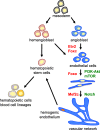Morphology regulation in vascular endothelial cells
- PMID: 30214642
- PMCID: PMC6130072
- DOI: 10.1186/s41232-018-0083-8
Morphology regulation in vascular endothelial cells
Abstract
Morphological change in endothelial cells is an initial and crucial step in the process of establishing a functional vascular network. Following or associated with differentiation and proliferation, endothelial cells elongate and assemble into linear cord-like vessels, subsequently forming a perfusable vascular tube. In vivo and in vitro studies have begun to outline the underlying genetic and signaling mechanisms behind endothelial cell morphology regulation. This review focuses on the transcription factors and signaling pathways regulating endothelial cell behavior, involved in morphology, during vascular development.
Keywords: Angiogenesis; Elongation; Endothelial cells; Morphology; Vasculature.
Conflict of interest statement
Not applicable.Not applicable.The authors declare that they have no competing interests.Springer Nature remains neutral with regard to jurisdictional claims in published maps and institutional affiliations.
Figures



References
-
- Stainier DY, Weinstein BM, Detrich HW, 3rd, Zon LI, Fishman MC. Cloche, an early acting zebrafish gene, is required by both the endothelial and hematopoietic lineages. Development. 1995;121(10):3141–3150. - PubMed
-
- Lee D, Park C, Lee H, Lugus JJ, Kim SH, Arentson E, Chung YS, Gomez G, Kyba M, Lin S, Janknecht R, Lim DS, Choi K. ER71 acts downstream of BMP, Notch, and Wnt signaling in blood and vessel progenitor specification. Cell Stem Cell. 2008;2(5):497–507. doi: 10.1016/j.stem.2008.03.008. - DOI - PMC - PubMed
Publication types
LinkOut - more resources
Full Text Sources
Other Literature Sources

